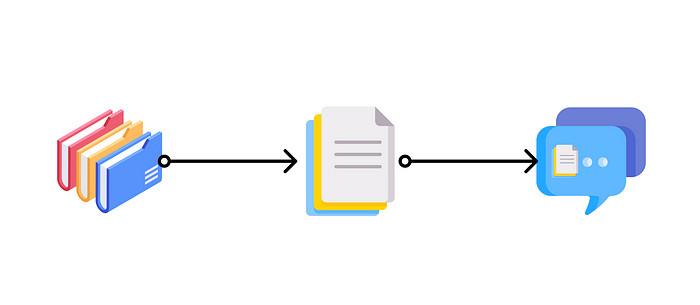How might we use it in a more productive way? With the recent release of the GPT 3.5 series API by OpenAI, we can do much more than just chit-chatting. One very productive use case for businesses and your personal use is QA (Question Answering) — you ask the bot in natural language about your own documents/data, and it can quickly answer you by retrieving info from the documents and generating a response [1]. You can use it for customer support, synthesizing user research, your personal knowledge management, and more!

In this article, I will explore how to build your own Q&A chatbot based on your own data, including why some approaches won’t work, and a step-by-step guide for building a document Q&A chatbot in an efficient way with llama-index and GPT API.
(If you only want to know how to build the Q&A chatbot, you can jump directly to the section “Building document Q&A chatbot step-by-step”)
Exploring different approaches
My day job is as a product manager — reading customer feedback and internal documents takes a big chunk of my life. When ChatGPT came out, I immediately thought of the idea of using it as an assistant to help me synthesize customer feedback or find related old product documents about the feature I’m working on.
I first thought of fine-tuning the GPT model with my own data to achieve the goal. But fine-tuning costs quite some money and requires a big dataset with examples. It’s also impossible to fine-tune every time when there is a change to the document. An even more crucial point is that fine-tuning simply CANNOT let the model “know” all the information in the documents, but rather it teaches the model a new skill. Therefore, for (multi-)document QA, fine-tuning is not the way to go.
The second approach that comes into my mind is prompt engineering by providing the context in the prompts. For example, instead of asking the question directly, I can append the original document content before the actual question. But the GPT model has a limited attention span — it can only take in a few thousand words in the prompt (about 4000 tokens or 3000 words). It’s impossible to give it all the context in the prompt, provided that we have thousands of customer feedback emails and hundreds of product documents. It’s also costly if you pass in a long context to the API because the pricing is based on the number of tokens you use.
I will ask you questions based on the following context:
— Start of Context —
YOUR DOCUMENT CONTENT
— End of Context—
My question is: “What features do users want to see in the app?”
(If you want to learn more about fine-tuning and prompt engineering for GPT, you can read the article: https://medium.com/design-bootcamp/3-ways-to-tailor-foundation-language-models-like-gpt-for-your-business-e68530a763bd)
Because the prompt has limitations on the number of input tokens, I came up with the idea of first using an algorithm to search the documents and pick out the relevant excerpts and then passing only these relevant contexts to the GPT model with my questions. While I was researching this idea, I came across a library called gpt-index (now renamed to LlamaIndex), which does exactly what I wanted to do and it is straightforward to use [2].

In the next section, I’ll give a step-by-step tutorial on using LlamaIndex and GPT to build a Q&A chatbot on your own data.
Building document Q&A chatbot step-by-step
In this section, we will build a Q&A chatbot based on existing documents with LlamaIndex and GPT (text-davinci-003), so that you can ask questions about your document and get an answer from the chatbot, all in natural language.
Prerequisites
Before we start the tutorial, we need to prepare a few things:
- Your OpenAI API Key, which can be found at https://platform.openai.com/account/api-keys.
- A database of your documents. LlamaIndex supports many different data sources like Notion, Google Docs, Asana, etc [3]. For this tutorial, we’ll just use a simple text file for demonstration.
- A local Python environment or an online Google Colab notebook.
Workflow
The workflow is straightforward and takes only a few steps:
- Build an index of your document data with LlamaIndex
- Query the index with natural language
- LlamaIndex will retrieve the relevant parts and pass them to the GPT prompt
- Ask GPT with the relevant context and construct a response
What LlamaIndex does is convert your original document data into a vectorized index, which is very efficient to query. It will use this index to find the most relevant parts based on the similarity of the query and the data. Then, it will plug in what’s retrieved into the prompt it will send to GPT so that GPT has the context for answering your question.
Setting Up
We’ll need to install the libraries first. Simply run the following command in your terminal or on Google Colab notebook. These commands will install both LlamaIndex and OpenAI.
!pip install llama-index
!pip install openai
Next, we’ll import the libraries in python and set up your OpenAI API key in a new .py file.
# Import necessary packages
from llama_index import GPTSimpleVectorIndex, Document, SimpleDirectoryReader
import os
os.environ['OPENAI_API_KEY'] = 'sk-YOUR-API-KEY'
Constructing the index and saving it
After we installed the required libraries and import them, we will need to construct an index of your document.
To load your document, you can use the SimpleDirectoryReader method provided by LllamaIndex or you can load it from strings.
# Loading from a directory
documents = SimpleDirectoryReader('your_directory').load_data()
# Loading from strings, assuming you saved your data to strings text1, text2, ...
text_list = [text1, text2, ...]
documents = [Document(t) for t in text_list]
LlamaIndex also provides a variety of data connectors, including Notion, Asana, Google Drive, Obsidian, etc. You can find the available data connectors at https://llamahub.ai/.
After loading the documents, we can then construct the index simply with
# Construct a simple vector index
index = GPTSimpleVectorIndex(documents)
If you want to save the index and load it for future use, you can use the following methods




